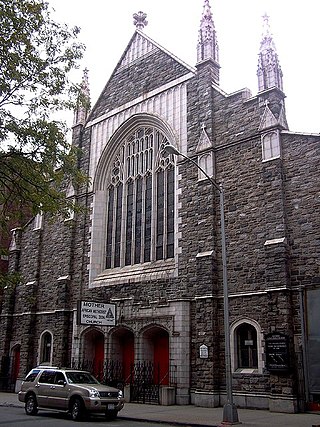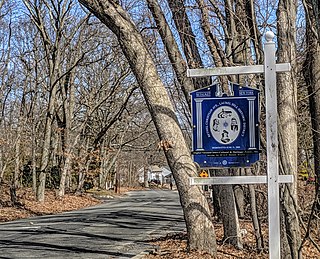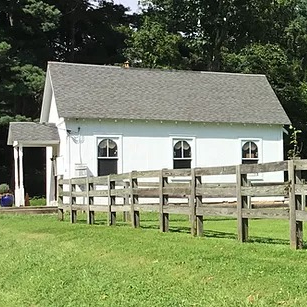
Sag Harbor is an incorporated village in Suffolk County, New York, United States, in the towns of Southampton and East Hampton on eastern Long Island. The village developed as a working port on Gardiners Bay. The population was 2,772 at the 2020 census.
Thomas James (1804–1891) had been a slave who became an African Methodist Episcopal Zion minister, abolitionist, administrator and author. He was active in New York and Massachusetts with abolitionists, and served with the American Missionary Association and the Union Army during the American Civil War to supervise the contraband camp in Louisville, Kentucky. After the war, he held national offices in the AME Church and was a missionary to black churches in Ohio. While in Massachusetts, he challenged the railroad's custom of forcing blacks into second-class carriages and won a reversal of the rule in the State Supreme Court. He wrote a short memoir published in 1886.

St. James AME Zion Church is a historic African Methodist Episcopal Zion church located at Ithaca in Tompkins County, New York. It is a two-story, frame church structure set on a high foundation and featuring a four-story entrance tower. The church structure was begun in the 1830s and modified many times since. The original stone meetinghouse was built in 1836 and is believed to be Ithaca's oldest church and one of the oldest in the AME Zion system.
Sag Harbor Whaling and Historical Museum is dedicated to the port town's past within the American whaling industry. It houses the largest collection of whaling equipment in the state of New York.

Timbuctoo is an unincorporated community in Westampton Township, Burlington County, New Jersey. Located along the Rancocas Creek, Timbuctoo was settled by formerly enslaved and free Black people, beginning in 1826. It includes Church St., Blue Jay Hill Road, and adjacent areas. At its peak in the mid-nineteenth century, Timbuctoo had more than 125 residents, a school, an AME Zion Church, and a cemetery. The key remaining evidence of this community is the cemetery on Church Street, which was formerly the site of Zion Wesleyan Methodist Episcopal African Church. Some current residents are descendants of early settlers.

The Mother African Methodist Episcopal Zion Church, also known as "Mother Zion", located at 140–148 West 137th Street between Adam Clayton Powell Jr. Boulevard and Lenox Avenue in the Harlem neighborhood of Manhattan, New York City, is the oldest African-American church in New York City, and the "mother church" of the African Methodist Episcopal Zion conference.

St. James Catholic Church and Cemetery, also known as St. James at Sag Bridge Church is a historic church and cemetery in the Sag Bridge area of the village of Lemont, Illinois. It is situated on a high bluff at the western tip of the glacier-carved Mount Forest Island, overlooking the Calumet Sag Channel and the community of Sag Bridge.

Bethel–Christian Avenue–Laurel Hill Historical District is a Setauket, Long Island, New York neighborhood that was nominated for preservation as an endangered historic site in 2017.
Edmund David Hollander is an American landscape architect and educator. A New York City native, he is the president of Hollander Design Landscape Architects, a New York-based firm known for environmental planning, landscape design and horticulture. The firm provides services to residential, commercial and civic clients.

Sag Harbor Hills, Azurest, and Ninevah Beach Subdivisions Historic District (SANS) is an African American beachfront community in Sag Harbor, New York. Founded following World War II, the SANS community served primarily as a summer retreat for middle-class African American families during the post-WWII and Jim Crow era. African American families were not allowed at beachfront resorts, pools or beaches, and SANS began as a place of refuge from racial strife. The historic district is bordered by Hempstead Street, Richards Drive, Hampton Street, Lincoln Street, Harding Terrace, Terry Drive and the eastern end of Haven's Beach in Sag Harbor. It was placed on the National Register of Historic Places on July 10, 2019.
Renee V.H. Simons is a former Fortune 500 executive and the president of SANS Sag Harbor, an award-winning nonprofit organization that successfully organized and advocated for the New York State and National Register of Historic Places registration of the historically Black beachfront enclaves in the Sag Harbor communities of Sag Harbor Hills, Azurest, and Ninevah Subdivisions.

The A.M.E. Zion Church of Kingston is an African Methodist Episcopal Zion Church located in Kingston, New York. Founded in 1848, as a land grant from wealthy Black residents, Mrs. Sarah-Ann Hasbrouck and her husband, Alexander, it is the oldest continuous African-American congregation in Kingston and Ulster County. The church is located at 26 Franklin Street in the city's Fourth Ward.

Mount Zion Cemetery is a historic African-American cemetery owned by the A.M.E. Zion Church of Kingston. The cemetery is on a 2.4-acre (0.97 ha) lot located at 190 South Wall Street in the city of Kingston. It is in the city's Fifth Ward, less than a mile south of the church.

The Stoutsburg Sourland African American Museum (SSAAM) is a history museum located in the Skillman section of Montgomery Township, New Jersey, United States. The museum is located at the Mount Zion African Methodist Episcopal Church, an African Methodist Episcopal church constructed in 1899. The church was added to the National Register of Historic Places on June 7, 2021.












